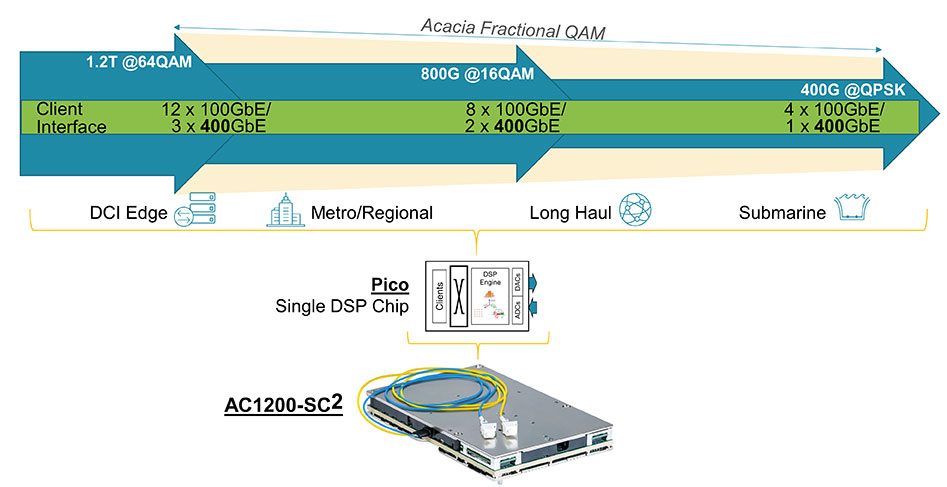Introduction
Bandwidth-intensive applications such as video streaming, virtual and augmented reality, artificial intelligence, and enterprise cloud services have been driving the ongoing rise of optical networking bandwidth requirements. In today’s high-capacity optical networks linking together data centers, high-bandwidth client traffic commonly terminates at 100G switch/router interfaces. This client traffic protocol is typically 100 Gigabit Ethernet (GbE). In addition, with global reaches of data center interconnects (DCI), it has become increasingly important to have the ability to terminate these 100G clients not only for intra- and inter-city distances but also for intercontinental distances.
A new generation of switch ASICs supporting 400G I/O is now leading network operators to question how their optical transport networks can support this emerging rate. With standards-based activities around 400GbE and advances in coherent solutions to support multiple 400G client traffic over an optical channel, network operators are looking for ways to support today’s 100G client traffic while also supporting emerging 400G client traffic across all key segments (DCI edge, metro, long-haul, submarine) of their network in an efficient, scalable, and cost-effective manner.
400GbE Anywhere and Everywhere
Figure 1 illustrates an example of how multi-haul coherent solutions, software configurable transponders that provide various transmission capacities and reaches by varying the modulation order and baud rate settings, can provide flexible options for network operators.

To ensure a smooth migration from 100GbE to 400GbE, it is important to have a solution that can efficiently transport either type of traffic, or a combination of both, without restrictions on performance or functionality. Not only is it important to be able to transport multiple 400GbE client signals, but an effective multi-haul solution should be able to support a wide range of modulation formats that can be optimized to match channel and reach requirements.
Acacia’s AC1200-SC2 (SC ‘squared’) coherent transponder module is the first coherent module that delivers up to three 400GbE client signals over a 1.2T single channel transmission utilizing a single-chip 1.2T DSP. Powered by Acacia’s Pico DSP, the AC1200-SC2 transponder module was built to enable network operators to support today’s 100GbE traffic with a 400GbE-ready network that can efficiently and cost-effectively accommodate applications from high-capacity DCI edge to terrestrial long-haul and submarine based on QPSK modulation, designed to ensure future scalability.
The AC1200-SC2 utilizes Acacia’s 3D shaping technology to optimize fiber capacity and reach by filling gaps in margin and spectrum, while also simplifying network planning with a scalable multi-generational channel plan, enabling network savings. 3D shaping allows fine-tune adjustment of the modulation order and baud rate to provide network operators with the flexibility to customize the transmission to their network requirements and improve capacity utilization.

150GHz Windows
As flexible WSS technology has become widely deployed, network operators are considering how to configure the spectral window/channel spacing requirements for next-generation line systems. Even though a WSS has the flexibility to support a wide range of desired channel spacings, it is preferable to utilize spacing based on regular multiples that can be combined without stranding spectrum due to fragmentation. Earlier generations of DWDM networks have deployed 50, 75 and 100GHz channels. As baud rates are increasing, transitioning to wider channels becomes a necessity. 150GHz channels fit nicely with legacy solutions (e.g., 50GHz, 75GHz, 100GHz), as well as next generation optics technology that could be based on baud rates in the range of 120 to 130Gbaud. Acacia’s AC1200-SC2 utilizes a single channel that can be optimized for legacy channel spacing up to 150GHz. In fact, in a wide range of channel spacings for 400G transmission, the AC1200-SC2 can be configured to utilize the lower modulation orders compared to other solutions.
Conclusion
Network operators are looking beyond transporting current 100G client traffic toward higher speed 400G traffic and seeking solutions that handle the steadily growing bandwidth demands being driven by new and exciting applications and services.
Acacia’s new AC1200-SC2 is built for transport systems to address the needs of network operators by enabling this migration to 400G with a flexible, high-performance solution that simplifies network operations. Higher speed 400G networks provide support for accommodating the growing client traffic across the entire network—from DCI edge, metro, long-haul, and all the way to submarine. Future proof your network today with the AC1200-SC2.
